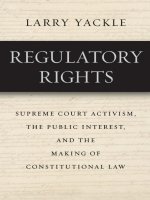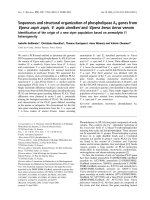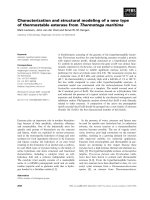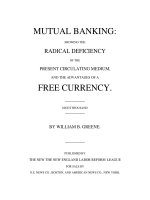mallaby - more money than god; hedge funds and the making of a new elite (2010)
Bạn đang xem bản rút gọn của tài liệu. Xem và tải ngay bản đầy đủ của tài liệu tại đây (3.08 MB, 497 trang )
MORE
MONEY
THAN
GOD
HEDGE FUNDS AND THE
MAKING OF A NEW ELITE
Sebastian Mallaby
A Council on Foreign Relations Book
THE PENGUIN PRESS
New York 2010
More
Money
Than
God
ALSO BY SEBASTIAN MALLABY
The World’s Banker: A Story of Failed States, Financial Crises,
and the Wealth and Poverty of Nations
After Apartheid: The Future of South Africa
MORE
MONEY
THAN
GOD
HEDGE FUNDS AND THE
MAKING OF A NEW ELITE
Sebastian Mallaby
A Council on Foreign Relations Book
THE PENGUIN PRESS
New York 2010
the penguin pr ess
Published by the Penguin Group
Penguin Group (USA) Inc., 375 Hudson Street, New York, New York 10014, U.S.A.
Penguin Group (Canada),
90 Eglinton Avenue East, Suite 700, Toronto, Ontario, Canada M4P 2Y3 (a division of Pearson Penguin Canada Inc. )
Penguin Books Ltd, 80 Strand, London WC2R 0RL, England
Penguin Ireland, 25 St. Stephen’s Green, Dublin 2,
Ireland (a division of Penguin Books Ltd)
Penguin Books Australia Ltd, 250 Camberwell Road, Camberwell,
Victoria 3124, Australia (a division of Pearson Australia Group Pty Ltd)
Penguin Books India Pvt Ltd, 11 Community
Centre, Panchsheel Park, New Delhi – 110 017, India
Penguin Group (NZ), 67 Apollo Drive, Rosedale, North Shore
0632, New Zealand (a division of Pearson New Zealand Ltd)
Penguin Books (South Africa) (Pty) Ltd,
24 Sturdee Avenue, Rosebank, Johannesburg 2196, South Africa
Penguin Books Ltd, Registered Offi ces:
80 Strand, London WC2R 0RL, England
First Published in 2010 by The Penguin Press,
a member of Penguin Group (USA) Inc.
Copyright © Sebastian Mallaby, 2010
All rights reserved
The Council on Foreign Relations (CFR) is an independent, nonpartisan membership organization, think tank, and
publisher dedicated to being a resource for its members, government officials, business executives, journalists, educators
and students, civic and religious leaders, and other interested citizens in order to help them better understand the world and
the foreign policy choices facing the United States and other countries. Founded in 1921, CFR carries out its mission by
maintaining a diverse membership, with special programs to promote interest and develop expertise in the next generation
of foreign policy leaders; convening meetings at its headquarters in New York and in Washington, DC, and other cities
where senior government officials, members of Congress, global leaders, and prominent thinkers come together with CFR
members to discuss and debate major international issues; supporting a Studies Program that fosters independent research,
enabling CFR scholars to produce articles, reports, and books and hold roundtables that analyze foreign policy issues and
make concrete policy recommendations; publishing Foreign Affairs, the preeminent journal on international affairs and U.S.
foreign policy; sponsoring Independent Task Forces that produce reports with both findings and policy prescriptions on the
most important foreign policy topics; and providing up- to-date information and analysis about world events and American
foreign policy on its website, www.cfr.org.
The Council on Foreign Relations takes no institutional position on policy issues and has no affiliation with the U.S.
government. All statements of fact and expressions of opinion contained in its publications are the sole responsibility of the
author or authors.
Photograph credits appear on page 483.
Library of Congress Cataloging-in-Publication Data
Mallaby, Sebastian.
More money than god : hedge funds and the making of a new elite / Sebastian Mallaby.
p. cm.
Includes bibliographical references and index.
ISBN: 1-101-45714-7
1. Hedge funds. 2. Investment advisors. I. Title.
HG4530.M249 2010
332.64'524— dc22
2009053253
designed by meigha n cavanaugh
Without limiting the rights under copyright reserved above, no part of this publication may be reproduced, stored in or
introduced into a retrieval system, or transmitted, in any form or by any means (electronic, mechanical, photocopying, recording
or otherwise), without the prior written permission of both the copyright owner and the above publisher of this book.
The scanning, uploading, and distribution of this book via the Internet or via any other means without the permission of the
publisher is illegal and punishable by law. Please purchase only authorized electronic editions and do not participate in or
encourage electronic piracy of copyrightable materials. Your support of the author’s rights is appreciated.
To my parents, Christopher and Pascale
Contents
Introduction : The Alpha Game 1
1. BIG DADDY 15
2. THE BLOCK TRADER 40
3. PAUL SAMUELSON’S SECRET 62
4. THE ALCHEMIST 83
5. TOP CAT 109
6. ROCK-AND-ROLL COWBOY 130
7. WHITE WEDNESDAY 147
8. HURRICANE GREENSPAN 172
9. SOROS VERSUS SOROS 193
10. THE ENEMY IS US 220
11. THE DOT-COM DOUBLE 248
12. THE YALE MEN 265
13. THE CODE BREAKERS 285
14. PREMONITIONS OF A CRISIS 307
15. RIDING THE STORM 323
16. “HOW COULD THEY DO THIS?” 348
CONCLUSION: SCARIER THAN WHAT? 373
Acknowledgments 392
Appendix I : Do the Tiger Funds Generate Alpha? 395
Appendix II: Performance of the Pioneers 400
Notes 408
Index 465
Photo Credits 483
Introduction:
The Alpha Game
T
he first hedge-fund manager, Alfred Winslow Jones, did not go to
business school. He did not possess a PhD in quantitative finance.
He did not spend his formative years at Morgan Stanley, Gold
-
man Sachs, or any other incubator for masters of the universe. Instead, he
took a job on a tramp steamer, studied at the Marxist Workers School in
Berlin, and ran secret missions for a clandestine anti-Nazi group called
the Leninist Organization. He married, divorced, and married again,
honeymooning on the front lines of the civil war in Spain, traveling and
drinking with Dorothy Parker and Ernest Hemingway. It was only at
the advanced age of forty-eight that Jones raked together $100,000 to set
up a “hedged fund,” generating extraordinary profits through the 1950s
and 1960s. Almost by accident, Jones improvised an investment structure
that has endured to this day. It will thrive for years to come, despite a
cacophony of naysayers.
Half a century after Jones created his hedge fund, a young man named
Clifford Asness followed in his footsteps. Asness did attend a business
school. He did acquire a PhD in quantitative finance. He did work for
Goldman Sachs, and he was a master of the universe. Whereas Jones had
launched his venture in his mature, starched-collar years, Asness rushed
into the business at the grand old age of thirty-one, beating all records for
2
MORE MONEY THAN GOD
a new start-up by raising an eye-popping $1 billion. Whereas Jones had
been discreet about his methods and the riches that they brought, Asness
was refreshingly open, tearing up his schedule to do TV interviews and
confessing to the New York Times that “it doesn’t suck” to be worth mil-
lions.
1
By the eve of the subprime mortgage crash in 2007, Asness’s fi rm,
AQR Capital Management, was running a remarkable $38 billion and
Asness himself personified the new globe-changing finance. He was irrev
-
erent, impatient, and scarcely even bothered to pretend to be grown up.
He had a collection of plastic superheroes in his offi ce.
2
Asness freely recognized his debt to Jones’s improvisation. His hedge
funds, like just about all hedge funds, embraced four features that Jones
had combined to spectacular effect. To begin with, there was a perfor
-
mance fee: Jones kept one fifth of the fund’s investment profits for himself
and his team, a formula that sharpened the incentives of his lieutenants.
Next, Jones made a conscious effort to avoid regulatory red tape, pre
-
serving the flexibility to shape-shift from one investment method to the
next as market opportunities mutated. But most important, from Asness’s
perspective, were two ideas that had framed Jones’s investment portfolio.
Jones had balanced purchases of promising shares with “short selling” of
unpromising ones, meaning that he borrowed and sold them, betting that
they would fall in value. By being “long” some stocks and “short” others,
he insulated his fund at least partially from general market swings; and
having hedged out market risk in this fashion, he felt safe in magnify
-
ing, or “leveraging,” his bets with borrowed money. As we will see in
the next chapter, this combination of hedging and leverage had a magi
-
cal effect on Jones’s portfolio of stocks. But its true genius was the one
that Asness emphasized later: The same combination could be applied to
bonds, futures, swaps, and options—and indeed to any mixture of these
instruments. More by luck than by design, Jones had invented a platform
for strategies more complex than he himself could dream of.
No definition of hedge funds is perfect, and not all the adventures
recounted in this book involve hedging and leverage. When George Soros
and Stan Druckenmiller broke the British pound, or when John Paulson
shorted the mortgage bubble in the United States, there was no particular
3
INTRODUCTION: THE ALPHA GAME
need to hedge—as we shall see later. When an intrepid commodities player
negotiated the purchase of the Russian government’s entire stock of non-
gold precious metals, leverage mattered less than the security around the
armored train that was to bring the palladium from Siberia. But even
when hedge funds are not using leverage and not actually hedging, the
platform created by A. W. Jones has proved exceptionally congenial. The
freedom to go long and short in any fi nancial instrument in any country
allows hedge funds to seize opportunities wherever they exist. The ability
to leverage allows hedge funds to size each bet to maximum effect. Perfor
-
mance fees create a powerful incentive to coin money.
Ah yes, that money! At his death in 1913, J. Pierpont Morgan had accu-
mulated a fortune of $1.4 billion in today’s dollars, earning the nickname
“Jupiter” because of his godlike power over Wall Street. But in the bubbly
first years of this century, the top hedge-fund managers amassed more
money than God in a couple of years of trading. They earned more—
vastly more—than the captains of Wall Street’s mightiest investment
banks and eclipsed even private-equity barons. In 2006 Goldman Sachs
awarded its chief executive, Lloyd C. Blankfein, an unprecedented $54
million, but the bottom guy on Alpha magazine’s list of the top twenty-fi ve
hedge-fund earners reportedly took home $240 million. That same year,
the leading private-equity partnership, Blackstone Group, rewarded its
boss, Stephen Schwarzman, with just under $400 million. But the top
three hedge-fund moguls each were said to have earned more than $1 bil-
lion.
3
The compensation formula devised by Jones conjured up hundreds
of fast fortunes, not to mention hundreds of fast cars in the suburbs of
Connecticut. Reporting from the epicenter of this gold rush, the Stam
-
ford Advocate observed that six local hedge-fund managers had pocketed
a combined $2.15 billion in 2006. The total personal income of all the
people in Connecticut came to $150 billion.
In the 1990s magazines drooled over the extravagance of dot-com mil-
lionaires, but now the spotlight was on hedge funds. Ken Griffi n, the
creator of Citadel Investment Group, bought himself a $50 million Bom
-
bardier Express private jet and had it fitted with a crib for his two-year-
old. Louis Bacon, the founder of Moore Capital, acquired an island in the
4
MORE MONEY THAN GOD
Great Peconic Bay, put transmitters on the local mud turtles to monitor
their mating habits, and hosted traditional English pheasant shoots. Ste
-
ven Cohen, the boss of SAC Capital, equipped his estate with a basketball
court, an indoor pool, a skating rink, a two-hole golf course, an organic
vegetable plot, paintings by van Gogh and Pollock, a sculpture by Keith
Haring, and a movie theater decorated with the pattern of the stars on his
wedding night sixteen years earlier. The hedge-fund titans were the new
Rockefellers, the new Carnegies, the new Vanderbilts. They were the new
American elite—the latest act in the carnival of creativity and greed that
powers the nation forward.
And what an elite this was. Hedge funds are the vehicles for loners and
contrarians, for individualists whose ambitions are too big to fit into estab
-
lished fi nancial institutions. Cliff Asness is a case in point. He had been a
rising star at Goldman Sachs, but he opted for the freedom and rewards of
running his own shop; a man who collects plastic superheroes is not going
to remain a salaried antihero for long, at least not if he can help it. Jim
Simons of Renaissance Technologies, the mathematician who emerged in
the 2000s as the highest earner in the industry, would not have lasted at a
mainstream bank: He took orders from nobody, seldom wore socks, and
got fired from the Pentagon’s code-cracking center after denouncing his
bosses’ Vietnam policy. Ken Griffin of Citadel, the second highest earner
in 2006, started out trading convertible bonds from his dorm room at Har
-
vard; he was the boy genius made good, the financial version of the entre-
prenerds who forged tech companies such as Google. The earliest pioneers
of the industry were cut from equally bright cloth. Julian Robertson staffed
his hedge fund with college athletes half his age; then he fl ew them out to
various retreats in the Rockies and raced them up the mountains. Michael
Steinhardt was capable of reducing underlings to sobs. “All I want to do is
kill myself,” one said. “Can I watch?” Steinhardt responded.
4
Like the Rockefellers and Carnegies before them, the new moguls made
their mark on the world beyond business and finance. George Soros was
the most ambitious in his reach: His charities fostered independent voices
in the emerging ex-communist nations; they pushed for the decrimi
-
nalization of drugs; they funded a rethink of laissez-faire economics. Paul
5
INTRODUCTION: THE ALPHA GAME
Tudor Jones, the founder of Tudor Investment Corporation, created Robin
Hood, one of the first “venture philanthropies” to fight poverty in New
York City: It identified innovative charities, set demanding benchmarks
for progress, and paid for performance. Bruce Kovner emerged as a god
-
father of the neoconservative movement, chairing the American Enterprise
Institute in Washington, D.C.; Michael Steinhardt bankrolled efforts to
create a new secular Judaism. But of course it was in finance that these
egos made the most impact. The story of hedge funds is the story of the
frontiers of finance: of innovation and increasing leverage, of spectacu
-
lar triumphs and humiliating falls, and of the debates spawned by these
dramas.
For much of their history, hedge funds have skirmished with the aca-
demic view of markets. Of course, academia is a broad church, teaming
with energetic skeptics. But from the mid 1960s to the mid 1980s, the
prevailing view was that the market is efficient, prices follow a random
walk, and hedge funds succeed mainly by being lucky. There is a powerful
logic to this account. If it were possible to know with any confi dence that
the price of a particular bond or equity is likely to move up, smart inves
-
tors would have pounced and it would have moved up already. Pouncing
investors ensure that all relevant information is already in prices, though
the next move of a stock will be determined by something unexpected. It
follows that professional money managers who try to foresee price moves
will generally fail in their mission. As this critique anticipates, plenty of
hedge funds have no real “edge”—if you strip away the marketing hype
and occasional flashes of dumb luck, there is no distinctive investment
insight that allows them to beat the market consistently. But for the suc
-
cessful funds that dominate the industry, the efficient-market indictment is
wrong. These hedge funds could drop their h and be called edge funds.
Where does this edge come from? Sometimes it consists simply of pick-
ing the best stocks. Despite everything that the finance literature asserts,
A. W. Jones, Julian Robertson, and many Robertson protégés clearly did
add value in this way, as we shall see presently. But frequently the edge
consists of exploiting kinks in the efficient-market theory that its propo
-
nents conceded at the start, even though they failed to emphasize them.
6
MORE MONEY THAN GOD
The theorists stipulated, for example, that prices would be effi cient only
if liquidity was perfect—a seller who offers a stock at the effi cient price
should always be able to find a buyer, since otherwise he will be forced
to offer a discount, rendering the price lower than the efficient level. But
in the 1970s and 1980s, a big pension fund that wanted to dump a large
block of shares could not actually find a buyer unless it offered a discount.
Michael Steinhardt made his fortune by milking these discounts in a sys
-
tematic way. An unassuming footnote in the efficient-market view became
the basis for a hedge-fund legend.
The nature of hedge funds’ true edge is often obscured by their bosses’
pronouncements. The titans sometimes seem like mystic geniuses: They
rack up glorious returns but cannot explain how they did it.
5
Perhaps the
most extreme version of this problem is presented by the young Paul Tudor
Jones. To this day, Jones maintains that he anticipated the 1987 crash
because his red-suspendered, twentysomething colleague, Peter Borish,
had mapped the 1980s market against the charts leading up to 1929; see
-
ing that the two lines looked the same, Jones realized that the break was
coming. But this explanation of Jones’s brilliant market timing is inad
-
equate, to say the least. For one thing, Borish admitted to massaging the
data to make the two lines fi t.
6
For another, he predicted that the crash
would hit in the spring of 1988; if Jones had really followed Borish’s coun
-
sel, he would have been wiped out when the crash arrived the previous
October. In short, Jones succeeded for reasons that we will explore later,
not for the reasons that he cites. The lesson is that genius does not always
understand itself—a lesson, incidentally, that is not confined to fi nance.
“Out of all the research that we’ve done with top players, we haven’t found
a single player who is consistent in knowing and explaining exactly what
he does,” the legendary tennis coach Vic Braden once complained. “They
give different answers at different times, or they have answers that simply
are not meaningful.”
7
Starting in the 1980s, financial academics came around to the view that
markets were not so efficient after all. Sometimes their conversions were
deliciously perfect. A young economist named Scott Irwin procured an
especially detailed price series for commodity markets from a small firm
7
INTRODUCTION: THE ALPHA GAME
in Indianapolis, and after painstaking analysis he proclaimed that prices
moved in trends—the changes were not random. Little did he know that,
almost twenty years earlier, a pioneering hedge fund called Commodities
Corporation had analyzed the same data, reached the same conclusion,
and programmed a computer to trade on it. Meanwhile, other researchers
acknowledged that markets were not perfectly liquid, as Steinhardt had
discovered long before, and that investors were not perfectly rational, a
truism to hedge-fund traders. The crash of 1987 underlined these doubts:
When the market’s valuation of corporate America changed by a fi fth in
a single trading day, it was hard to believe that the valuation deserved
much deference. “If the efficient markets hypothesis was a publicly traded
security, its price would be enormously volatile,” the Harvard economists
Andrei Shleifer and Lawrence Summers wrote mockingly in 1990. “But
the stock in the efficient markets hypothesis—at least as it has tradition
-
ally been formulated—crashed along with the rest of the market on Octo-
ber 19, 1987.”
8
The acknowledgment of the limits to market efficiency had a profound
effect on hedge funds. Before, the prevailing line from the academy had
been that hedge funds would fail. After, lines of academics were queuing
up to join them. If markets were inefficient, there was money to be made,
and the finance professors saw no reason why they should not be the ones
to profit. Cliff Asness was fairly typical of the new wave. At the University
of Chicago’s Graduate School of Business, his thesis adviser was Eugene
Fama, one of the fathers of the efficient-market hypothesis. But by 1988,
when Asness arrived in Chicago, Fama was leading the revisionist charge:
Along with a younger colleague, Kenneth French, Fama discovered non
-
random patterns in markets that could be lucrative for traders. After con-
tributing to this literature, Asness headed off to Wall Street and soon
opened his hedge fund. In similar fashion, the Nobel laureates Myron
Scholes and Robert Merton, whose formula for pricing options grew out
of the efficient-markets school, signed up with the hedge fund Long-Term
Capital Management. Andrei Shleifer, the Harvard economist who had
compared the efficient-market theory to a crashing stock, helped to create
an investment company called LSV with two fellow finance professors.
8
MORE MONEY THAN GOD
His coauthor, Lawrence Summers, made the most of a gap between stints
as president of Harvard and economic adviser to President Obama to sign
on with D. E. Shaw, a quantitative hedge fund.
9
Yet the biggest effect of the new inefficient-market consensus was not
that academics flocked to hedge funds. It was that institutional investors
acquired a license to entrust vast amounts of capital to them. Again, the
years after the 1987 crash were an inflection point. Before, most money
in hedge funds had come from rich individuals, who presumably had not
heard academia’s message that it was impossible to beat the market. After,
most money in hedge funds came from endowments, which had been told
by their learned consultants that the market could be beaten—and which
wanted in on the action. The new wave was led by David Swensen, the
boss of the Yale endowment, who focused on two things. If there were sys
-
tematic patterns in markets of the sort that Fama, French, and Asness had
identified, then hedge funds could milk these in a systematic way: There
were strategies that could be expected to do well, and they could be identi
-
fied prospectively. Further, the profits from these strategies would be more
than just good on their own terms. They would reduce an endowment’s
overall risk through the magic of diversifi cation. The funds that Swensen
invested in were certainly diverse: In 2002, a swashbuckling West Coast
fund named Farallon swooped into Indonesia and bought the country’s
largest bank, undeterred by the fact that a currency collapse, a political
revolution, and Islamist extremism had scared most westerners out of the
country. Following Swensen’s example, endowments poured money into
hedge funds from the 1990s on, seeking the uncorrelated returns that
endowment gurus called “alpha.”
The new inefficient-market view also imbued hedge funds with a
social function. This was the last thing they had sought: They had gotten
into the alpha game with one purpose above all, and that was to make
money. But if alpha existed because markets were inefficient, it followed
that savings were being allocated in an irrational manner. The research of
Fama and French, for example, showed that unglamorous “value” stocks
were underpriced relative to overhyped “growth” stocks. This meant that
capital was being provided too expensively to solid, workhorse fi rms and
9
INTRODUCTION: THE ALPHA GAME
too cheaply to their flashier rivals: Opportunities for growth were being
squandered. Similarly, the discounts in block trading showed that prices
could be capricious in small ways, raising risks to investors, who in turn
raised the premium that they charged to users of their capital. It was the
function of hedge funds to correct inefficiencies like these. By buying
value stocks and shorting growth stocks, Cliff Asness was doing his part
to reduce the unhealthy bias against solid, workhorse firms. By buying
Ford’s stock when it dipped illogically after a large-block sale, Michael
Steinhardt was ensuring that the grandma who owned a piece of Ford
could always count on getting a fair price for it. By computerizing Stein-
hardt’s art, statistical arbitrageurs such as Jim Simons and David Shaw
were taking his mission to the next level. The more markets could be
rendered efficient, the more capital would flow to its most productive uses.
The less prices got out of line, the less risk there would presumably be of
financial bubbles—and so of sharp, destabilizing corrections. By fl atten
-
ing out the kinks in market behavior, hedge funds were contributing to
what economists called the “Great Moderation.”
But hedge funds also raised an unsettling question. If markets were
prone to wild bubbles and crashes, might not the wildest players render
the turbulence still crazier? In 1994, the Federal Reserve announced a tiny
one-quarter-of-a-percentage-point rise in short-term interest rates, and the
bond market went into a mad spin; leveraged hedge funds had been wrong-
footed by the move, and they began dumping positions furiously. Foreshad
-
owing future financial panics, the turmoil spread from the United States
to Japan, Europe, and the emerging world; several hedge funds sank, and
for a few hours it even looked as though the storied fi rm of Bankers Trust
might be dragged down with them. As if this were not warning enough,
the world was treated to another hedge-fund failure four years later, when
Long-Term Capital Management and its crew of Nobel laureates went bust;
terrified that a chaotic bankruptcy would topple Lehman Brothers and
other dominoes besides, panicked regulators rushed in to oversee LTCM’s
burial. Meanwhile, hedge funds wreaked havoc with exchange-rate poli
-
cies in Europe and Asia. After the East Asian crisis, Malaysia’s prime min-
ister, Mahathir Mohamad, lamented that “all these countries have spent
10
MORE MONEY THAN GOD
40 years trying to build up their economies and a moron like Soros comes
along with a lot of money to speculate and ruins things.”
10
And so, by the start of the twenty-first century, there were two compet-
ing views of hedge funds. Sometimes the funds were celebrated as the sta-
bilizing heroes who muscled inefficient prices into line. Sometimes they
were vilified as the weak links whose own instability or wanton aggression
threatened the global economy. The heart of the matter was the leverage
embraced by A. W. Jones—or rather, a vastly expanded version of it. Lever
-
age gave hedge funds the ammunition to trade in greater volume, and so
to render prices more efficient and stable. But leverage also made hedge
funds vulnerable to shocks: If their trades moved against them, they could
burn through thin cushions of capital at lightning speed, obliging them to
dump positions fast—destabilizing prices.
11
After the bond-market melt-
down of 1994 and the Long-Term Capital failure in 1998, the two com-
peting views of hedge funds wrestled to a stalemate. In the United States
and Britain, hedge funds’ stabilizing impact received the most emphasis;
elsewhere, the risk of destabilizing panics got most of the attention. Fun
-
nily enough, the countries that liked hedge funds the best were also the
ones that hosted them.
Then came the crisis of 2007–2009, and every judgment about fi nance
was thrown into question. Whereas the market disruptions of the 1990s
could be viewed as a tolerable price to pay for the benefits of sophisti
-
cated and leveraged finance, the convulsion of 2007–2009 triggered the
sharpest recession since the 1930s. Inevitably, hedge funds were caught up
in the panic. In July 2007, a credit hedge fund called Sowood blew up,
and the following month a dozen or so quantitative hedge funds tried to
cut their positions all at once, triggering wild swings in the equity market
and billions of dollars of losses. The following year was more brutal by
far. The collapse of Lehman Brothers left some hedge funds with money
trapped inside the bankrupt shell, and the turmoil that followed infl icted
losses on most others. Hedge funds needed access to leverage, but nobody
lent to anyone in the weeks after the Lehman shock. Hedge funds built
their strategies on short selling, but governments imposed clumsy restric
-
tions on shorting amid the post-Lehman panic. Hedge funds were reliant
11
INTRODUCTION: THE ALPHA GAME
upon the patience of their investors, who could yank their money out
on short notice. But patience ended abruptly when markets went into a
tailspin. Investors demanded their capital back, and some funds withheld
it by imposing “gates.” Surely now it was obvious that the risks posed by
hedge funds outweighed the benefits? Far from bringing about the Great
Moderation, they had helped to trigger the Great Cataclysm.
This conclusion, though tempting, is almost certainly mistaken. The
cataclysm has indeed shown that the financial system is broken, but it has
not actually shown that hedge funds are the problem. It has demonstrated,
to begin with, that central banks may have to steer economies in a new
way: Rather than targeting consumer-price inflation and turning a blind
eye to asset-price inflation, they must try to let the air out of bubbles—a
lesson first suggested, incidentally, by the hedge-fund blowup of 1994. If
the Fed had curbed leverage and raised interest rates in the mid 2000s,
there would have been less craziness up and down the chain. American
households would not have increased their borrowing from 66 percent of
GDP in 1997 to 100 percent a decade later. Housing fi nance companies
would not have sold so many mortgages regardless of borrowers’ ability
to repay. Fannie Mae and Freddie Mac, the two government-chartered
home lenders, would almost certainly not have collapsed into the arms
of the government. Banks like Citigroup and broker-dealers like Merrill
Lynch would not have gorged so greedily on mortgage-backed securities
that ultimately went bad, squandering their capital. The Fed allowed this
binge of borrowing because it was focused resolutely on consumer-price
inflation, and because it believed it could ignore bubbles safely. The car
-
nage of 2007–2009 demonstrated how wrong that was. Presented with an
opportunity to borrow at near zero cost, people borrowed unsustainably.
The crisis has also shown that fi nancial firms are riddled with dysfunc-
tional incentives. The clearest problem is “too big to fail”—Wall Street
behemoths load up on risk because they expect taxpayers to bail them out,
and other market players are happy to abet this recklessness because they
also believe in the government backstop. But this too-big-to-fail problem
exists primarily at institutions that the government has actually rescued:
commercial banks such as Citigroup; former investment banks such as
12
MORE MONEY THAN GOD
Goldman Sachs and Morgan Stanley; insurers such as AIG; the money-
market funds that received an emergency government guarantee at the
height of the crisis. By contrast, hedge funds made it through the mayhem
without receiving any direct taxpayer assistance: There is no precedent
that says that the government stands behind them. Even when Long-Term
Capital collapsed in 1998, the Fed oversaw its burial but provided no
money to cover its losses. At some point in the future, a supersized hedge
fund may prove to be too big to fail, which is why the largest and most
leveraged should be subject to regulation. But the great majority of hedge
funds are too small to threaten the broader financial system. They are safe
to fail, even if they are not fail-safe.
12
The other skewed incentive in finance involves traders’ pay packages.
When traders take enormous risks, they earn fortunes if the bets pay off.
But if the bets go wrong, they don’t endure symmetrical punishment—
the performance fees and bonuses dry up, but they do not go negative.
Again, this heads-I-win-tails-you-lose problem is sharper at banks than at
hedge funds. Hedge funds tend to have “high-water marks”: If they lose
money one year, they take reduced or even no performance fees until they
earn back their losses. Hedge-fund bosses mostly have their own money
in their funds, so they are speculating with capital that is at least partly
their own—a powerful incentive to avoid losses. By contrast, bank traders
generally face fewer such restraints; they are simply risking other people’s
money. Perhaps it is no surprise that the typical hedge fund is far more
cautious in its use of leverage than the typical bank. The average hedge
fund borrows only one or two times its investors’ capital, and even those
that are considered highly leveraged generally borrow less than ten times.
Meanwhile investment banks such as Goldman Sachs or Lehman Broth
-
ers were leveraged thirty to one before the crisis, and commercial banks
like Citi were even higher by some measures.
13
The very structure of hedge funds promotes a paranoid discipline.
Banks tend to be establishment institutions with comfortable bosses;
hedge funds tend to be scrappy upstarts with bosses who think nothing of
staying up all night to see a deal close. Banks collect savings from house
-
holds with the help of government deposit insurance; hedge funds have to
13
INTRODUCTION: THE ALPHA GAME
demonstrate that they can manage risk before they can raise money from
clients. Banks know that if they face a liquidity crisis they have access to
the central bank’s emergency lending, so they are willing to rely heavily
on short-term loans; hedge funds have no such safety net, so they are
increasingly reluctant to depend on short-term lending. Banks take the
view that everything is going wonderfully so long as borrowers repay;
hedge funds mark their portfolios to market, meaning that slight blips in
the risk that borrowers will hit trouble in the future can affect the hedge
funds’ bottom line immediately.
14
Banks’ investment judgment is often
warped by their pursuit of underwriting or advisory fees; hedge funds live
and die by their investment performance, so they are less distracted and
conflicted. For all these reasons, a proper definition of hedge funds should
stress their independence. So-called hedge funds that are the subsidiaries
of large banks lack the paranoia and focus that give true hedge funds their
special character.
As I finished writing this book, in early 2010, regulators seemed poised
to clamp down on the financial industry. To a large extent, their instincts
were right: At their peak, financial companies hogged more human capital
than they deserved, and they took risks that cost societies dearly. But Wall
Street’s critics should pause before they sweep hedge funds into their net.
Who, in the final analysis, will manage risk better? Commercial banks and
investment banks, which either blew up or were bailed out by the govern
-
ment? Mutual-fund companies, which peddled money-market products
that the government was forced to backstop? And which sort of future do
the critics favor: one in which risk is concentrated inside giant banks for
which taxpayers are on the hook, or one in which risk is dispersed across
smaller hedge funds that expect no lifelines from the government? The
crisis has compounded the moral hazard at the heart of finance: Banks
that have been rescued can expect to be rescued all over again the next
time they blow up; because of that expectation, they have weak incentives
to avoid excessive risks, making blowup all too likely. Capitalism works
only when institutions are forced to absorb the consequences of the risks
that they take on. When banks can pocket the upside while spreading the
cost of their failures, failure is almost certain.









